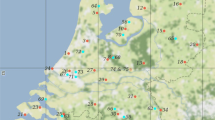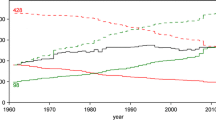Abstract
The meteorological measurements in Brno, Czech Republic, is among the world’s oldest measurements, operating since 1799. Like many others, station was initially installed in the city center, relocated several times, and currently operates at an airport outside the city. These geographical changes potentially bias the temperature record due to different station surroundings and varying degrees of urban heat island effects. Here, we assess the influence of land cover on spatial temperature variations in Brno, capitol of Moravia and the second largest city of the Czech Republic. We therefore use a unique dataset of half-hourly resolved measurements from 11 stations spanning a period of more than 3.5 years and apply this information to reduce relocation biases in the long-term temperature record from 1799 to the present. Regression analysis reveals a significant warming influence from nearby buildings and a cooling influence from vegetation, explaining up to 80% of the spatial variability within our network. The influence is strongest during the warm season and for land cover changes between 300 and 500 m around stations. Relying on historical maps and recent satellite data, it was possible to capture the building densities surrounding the past locations of the meteorological station. Using the previously established land cover–temperature relation, the anthropogenic warming for each measurement site could be quantified and hence eliminated from the temperature record accordingly, thereby increasing the long-term warming trend.





Similar content being viewed by others
References
Aguilar E, Auer I, Brunet M, Peterson TC, Wieringa J (2003) Guidelines on climate metadata and homogenization WMO/TD 1186
Allen L, Lindberg F, Grimmond CSB (2011) Global to city scale urban anthropogenic heat flux: model and variability. Int J Climatol 31:1990–2005
Arnfield AJ (2003) Two decades of urban climate research: a review of turbulence, exchanges of energy and water, and the urban heat island. Int J Clim 23:1–26. https://doi.org/10.1002/joc.859
Auer I et al (2005) A new instrumental precipitation dataset for the greater alpine region for the period 1800-2002. Int J Clim 25:139–166. https://doi.org/10.1002/joc.1135
Auer I et al (2007) HISTALP—historical instrumental climatological surface time series of the Greater Alpine Region. Int J Clim 27:17–46. https://doi.org/10.1002/joc.1377
Begert M, Schlegel T, Kirchhofer W (2005) Homogeneous temperature and precipitation series of Switzerland from 1864 to 2000. Int J Climatol 25:65–80
Böhm R, Jones PD, Hiebl J, Frank D, Brunetti M, Maugeri M (2009) The early instrumental warm-bias: a solution for long central European temperature series 1760–2007. Clim Chang 101:41–67. https://doi.org/10.1007/s10584-009-9649-4
Bozsaky D (2010) The historical development of thermal insulation materials. Periodica Polytechnica Architecture 41(2):49
Brázdil R, Řezníčková L, Valášek H (2006) Early instrumental meteorological observations in the Czech lands I: Ferdinand Knittelmayer, Brno, 1799-1812. Meteorologický časopis 9:59–71
Brunet M et al (2006a) A case-study/guidance on the development of long-term daily adjusted temperature datasets WMO/TD 1425
Brunet M et al (2006b) The development of a new dataset of Spanish Daily Adjusted Temperature Series (SDATS) (1850–2003). Int J Climatol 26:1777–1802. https://doi.org/10.1002/joc.1338
Chen X-L, Zhao H-M, Li P-X, Yin Z-Y (2006) Remote sensing image-based analysis of the relationship between urban heat island and land use/cover changes. Remote Sens Environ 104:133–146
Chow W, Roth M (2006) Temporal dynamics of the urban heat island of Singapore. Int J Clim 26:2243–2260. https://doi.org/10.1002/joc.1364
Cox PM, Betts RA, Bunton CB, Essery RLH, Rowntree PR, Smith J (1999) The impact of new land surface physics on the GCM simulation of climate and climate sensitivity. Clim Dyn 15:183–203. https://doi.org/10.1007/s003820050276
Dienst M, Lindén J, Engström E, Esper J (2017) Removing the relocation bias from the 155-year Haparanda temperature record in northern Europe. Int J Climatol 37:4015–4026. https://doi.org/10.1002/joc.4981
Dimoudi A, Nikolopoulou M (2003) Vegetation in the urban environment: microclimatic analysis and benefits. Energ Buildings 35:69–76
Dobrovolný P et al (2012) Klima Brna. Víceúrovňová analýza městského klimatu. Brno
Erk F (1883) Die Bestimmung wahrer Tagesmittel der Temperatur unter besonderer Berücksichtigung langjähriger Beobachtungen von München. Verl. d. Akad. München 1883. Abhandlungen: Bd. 14, Abth. 2 = [9]
Esper J, Frank D, Büntgen U (2007) On selected issues and challenges in dendroclimatology. In: Kienast F, Wildi O, Ghosh S (eds) A changing world: challenges for landscape research. Springer, Berlin, pp 113–132
Gaffin SR et al (2008) Variations in New York city’s urban heat island strength over time and space. Theor Appl Climatol 94:1–11. https://doi.org/10.1007/s00704-007-0368-3
Giridharan R, Kolokotroni M (2009) Urban heat island characteristics in London during winter. Sol Energy 83:1668–1682. https://doi.org/10.1016/j.solener.2009.06.007
Giridharan R, Lau SSY, Ganesan S, Givoni B (2007) Urban design factors influencing heat island intensity in high-rise high-density environments of Hong Kong. Build Environ 42:3669–3684. https://doi.org/10.1016/j.buildenv.2006.09.011
Goodridge JD, (1992) Urban bias influences on long-term California air temperature trends. Atmospheric Environment. Part B. Urban Atmosphere 26 (1):1–7. https://doi.org/10.1016/0957-1272(92)90032-n
Hart MA, Sailor DJ (2009) Quantifying the influence of land-use and surface characteristics on spatial variability in the urban heat island. Theor Appl Climatol 95:397–406. https://doi.org/10.1007/s00704-008-0017-5
Ho HC et al (2014) Mapping maximum urban air temperature on hot summer days. Remote Sens Environ 154:38–45
Huang L, Li J, Zhao D, Zhu J (2008) A fieldwork study on the diurnal changes of urban microclimate in four types of ground cover and urban heat island of Nanjing, China. Build Environ 43:7–17. https://doi.org/10.1016/j.buildenv.2006.11.025
Jones PD, Lister D, Li Q (2008) Urbanization effects in large-scale temperature records, with an emphasis on China. J Geophys Res 113:1–12
Kalnay E, Cai M (2003) Impact of urbanization and land-use change on climate. Nature 423:528–531
Kolokotsa D, Psomas A, Karapidakis E, (2009) Urban heat island in southern Europe: the case study of Hania, Crete. Solar Energy 83(10):1871–1883. https://doi.org/10.1016/j.solener.2009.06.018
Leach AJ (2007) The climate change learning curve. J Econ Dyn Control 31:1728–1752. https://doi.org/10.1016/j.jedc.2006.06.001
Li RM, Roth M (2009) Spatial variation of the canopy-level urban heat island in Singapore. Paper presented at the seventh International Conference on Urban Climate, Yokohama, Japan
Lindén J (2011) Nocturnal cool island in the Sahelian city of Ouagadougou, Burkina Faso. Int J Climatol 31:605–620
Lindén J, Esper J, Holmer B (2015) Using land cover, population, and night light data for assessing local temperature differences in Mainz, Germany. J Appl Meteorol Climatol 54:658–670
Lo CP, Quattrochi DA (2003) Land-use and land-cover change, urban heat island phenomenon, and health implications: a remote sensing approach. Photogramm Eng Remote Sens 69:1053–1063
Moberg A, Bergström H (1997) Homogenization of Swedish temperature data - part III - the long temperature records from Uppsala and Stockholm. Int J Climatol 17:667–699
Morris CJG, Simmonds I, Plummer N (2001) Qualification of the influences of wind and cloud on the nocturnal urban heat island of a large city. J Appl Meteorol 40:169–182
Oke TR (1982) The energetic basis of the urban heat island. Q J R Meteorol Soc 108:1–24
Parker DE (2010) Urban heat island effects on estimates of observed climate change. Wiley Interdiscip Rev Clim Chang 1(1):123–133
Peel MC, Finlayson BL, Mcmahon TA (2007) Updated world map of the Köppen-Geiger climate classification. Hydrol Earth Syst Sci Discuss EGU 11:1633–1644
Pérez-Zanón N, Sigró J, Domonkos P, Ashcroft L (2015) Comparison of HOMER and ACMANT homogenization methods using a central Pyrenees temperature dataset. Adv Sci Res 12:111–119. https://doi.org/10.5194/asr-12-111-2015
Portman DA (1993) Identifying and correcting urban bias in regional time series: surface temperature in China’s Northern Plains. J Climate 6:2298–2308. https://doi.org/10.1175/1520-0442(1993)006<2298:iacubi>2.0.co;2
Rahimzadeh F, Zavareh MN (2014) Effects of adjustment for non-climatic discontinuities on determination of temperature trends and variability over Iran. Int J Climatol 34:2079–2096
Štěpánek P, Zahradníček P, Skalák P (2009) Data quality control and homogenization of air temperature and precipitation series in the area of the Czech Republic in the period 1961–2007. Adv Sci Res 3:23–26. https://doi.org/10.5194/asr-3-23-2009
Stewart ID, Oke TR (2012) Local climate zones for urban temperature studies. Bull Am Meteorol Soc 93:1879–1900. https://doi.org/10.1175/bams-d-11-00019.1
Syrakova M, Stefanova M (2008) Homogenization of Bulgarian temperature series. Int J Climatol 29:1835–1849
Taha H (1997) Urban climates and heat islands: albedo, evapotranspiration, and anthropogenic heat. Energ Buildings 25:99–103
Tuomenvirta H (2001) Homogeneity adjustments of temperature and precipitation series - Finnish and Nordic data. Int J Climatol 21:495–506
Unwin DJ (1980) The synoptic climatology of Birmingham’s urban heat island, 1965–74. Weather 35:43–50
Valentin J (1901) Der tägliche Gang der Lufttemperatur in Österreich Veröffentlichungen des Preußischen Meteorologischen Instituts 254
Venema V et al (2012a) Benchmarking homogenization algorithms for monthly data. Clim Past 8:89–115
Venema V et al (2012b) Detecting and repairing inhomogeneities in datasets, assessing current capabilities. Bull Am Meteorol Soc 93:951–954
Vincent LA (1998) A technique for the identification of inhomogeneities in Canadian temperature series. J Climate 11:1094–1104. https://doi.org/10.1175/1520-0442(1998)011<1094:atftio>2.0.co;2
Voldoire A et al (2012) The CNRM-CM5.1 global climate model: description and basic evaluation. Clim Dyn 40:2091–2121. https://doi.org/10.1007/s00382-011-1259-y
Wang ZH, Zhao X, Yang J, Song J (2016) Cooling and energy saving potentials of shade trees and urban lawns in a desert city. Appl Energy 161:437–444. https://doi.org/10.1016/j.apenergy.2015.10.047
Weng Q, Lu D, Schubring J (2004) Estimation of land surface temperature–vegetation abundance relationship for urban heat island studies. Remote Sens Environ 89:467–483. https://doi.org/10.1016/j.rse.2003.11.005
Wicki A, Parlow E, Feigenwinter C (2018) Evaluation and modeling of urban heat island intensity in Basel, Switzerland. Climate 6(3):55
Wigley TML, Santer BD (2013) A probabilistic quantification of the anthropogenic component of twentieth century global warming. Clim Dyn 40:1087–1102. https://doi.org/10.1007/s00382-012-1585-8
Yang P, Ren G, Liu W (2013) spatial and temporal characteristics of Bejing urban heat island instensity. J Appl Meteorol Climatol 52:1803–1816
Yokobori T, Ohta S (2009) Effect of land cover on air temperatures involved in the development of an intra-urban heat island. Clim Res 39:61–73. https://doi.org/10.3354/cr00800
Zhang L, Ren G, Ren Y, Zhang A, Chu Z, Zhou Y (2014) Effect of data homogenization on estimate of temperature trend: a case of Huairou station in Bejing municipality. Theor Appl Climatol 115:365–373
Zhen L and Zhong-Wei Y (2015) Homogenized Daily Mean/Maximum/Minimum Temperature Series for China from 1960-2008. Atmospheric and Oceanic Science Letters 2(4):237–243
Author information
Authors and Affiliations
Corresponding author
Additional information
Publisher’s note
Springer Nature remains neutral with regard to jurisdictional claims in published maps and institutional affiliations.
Rights and permissions
About this article
Cite this article
Knerr, I., Dienst, M., Lindén, J. et al. Addressing the relocation bias in a long temperature record by means of land cover assessment. Theor Appl Climatol 137, 2853–2863 (2019). https://doi.org/10.1007/s00704-019-02783-2
Received:
Accepted:
Published:
Issue Date:
DOI: https://doi.org/10.1007/s00704-019-02783-2




